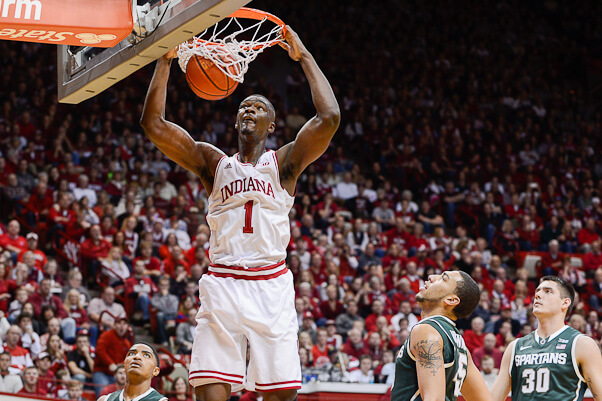Data dive: Noah Vonleh’s usage

(Editor’s note: Seth Hendrickson has joined Inside the Hall as a contributor and will use a system he developed that takes publicly available play-by-play data from college basketball games and organizes and extracts as much information as possible to gain a better of understanding of the game. A native of Crawfordsville, Indiana, Hendrickson holds an undergraduate degree in electrical engineering from Rose Hulman and a masters degree from Georgia Tech.)
Noah Vonleh shoots a field goal percentage of 53.9, while the rest of his teammates are good for a combined 43.7 percent. Of the players that log significant minutes, Vonleh shoots six percent better than the next closest player, Stanford Robinson.
For a team that struggles to score efficiently at times, it is logical to conclude that Indiana should be getting the ball into Vonleh’s hands as much as possible. However, much like Cody Zeller before him, the Hoosiers have trouble involving their most efficient scorer for long stretches of important games.
Additionally, Indiana seems to emphasize getting their big man the ball at the beginning of the game, and to great success, but then deviates from this strategy as the game wears on. Gaining a statistical perspective on this matter is possible by mining through the play-by-play data for each of Indiana’s games this season.
Specifically, the number of possessions in which Indiana “used” Noah Vonleh compared to the total number of possessions will be examined in the first edition of data dive. A player is “used” on a possession if, at any point during the possession, he registers a field-goal attempt, free-throw attempt or a turnover. This measure is a variation on the usage percentage metric defined here.

The data seems to indicate a downward trend as the game time goes on, but the trend is not overwhelmingly clear. The trend for the first half of the game, however, is obviously downward. The second half shows a bit of a spike at the start, which is not surprising due to a re-emphasis of getting Vonleh touches coming out of halftime, but the rest of the half is more sporadic. The third largest spike, which comes at 33 minutes, could be explained by the fact that this is around the time that Vonleh would re-enter the game if he were in foul trouble.
Though the overall trend isn’t obvious, statistical tests can be performed on the data to give a definitive answer. A quick regression analysis — a statistical tool for identifying trends — shows that there is a downward correlation with a statistical confidence level of 95.4 percent. In other words, there is a 95.4 percent chance that the trend is real.
In short, Indiana loses its focus of getting the ball to Noah as the game goes on. By comparison, neither Michigan State for Adreian Payne nor Iowa for Aaron White show the same trend in similar analysis. Each of these teams is much more consistent in getting their big man the ball.
Having established this, an understandable question would be to ask if the Hoosiers are getting better as the season moves forward. Tracking the evolution of Vonleh’s usage percentage for each game throughout the season helps to identify any noticeable improvement:

This chart shows that the Hoosiers have, on the whole, been worse at finding Vonleh on the offensive end as the season has progressed. While Vonleh’s usage percentage was very high at the start of the season, the Hoosiers have clearly struggled to maintain consistency as the competition gets tougher and the scouting report becomes more focused on IU’s star freshman.
The Big Ten season has been a bit of a mixed bag, with the team struggling to keep Vonleh involved consistently. Of course, getting the ball down to the post is significantly more difficult against bigger, more-talented Big Ten defensive units, a fact which should be taken into consideration for the in-conference numbers.
A look at some of the worst scoring droughts the Hoosiers have gone through during the conference season further reinforces the importance of keeping Vonleh involved in the offense. The figure below shows a breakdown of which players have attempted shots during some of the major scoring droughts in the conference schedule thus far.

Two players which are clearly above their season average for many of these scoring droughts are Robinson and Yogi Ferrell, while Vonleh takes on a diminished role. Out of the 13 points displayed, only three times has Vonleh been above his conference season average in percentage of field goals attempted.
Vonleh did not attempt a single shot in one particularly gruesome stretch, a 12 minute segment versus Illinois where Indiana didn’t manage to make one field goal. It is also of note that Indiana won only one of the six games shown, overcoming a 15-point deficit to Penn State in Happy Valley.
With the conference season more than halfway over, it doesn’t seem likely that scoring responsibilities will change much. Ferrell and Vonleh figure to make up the bulk of the scouting report on the Hoosiers’ offense, which means Big Ten teams will do everything they can to prevent the post entry. How the Hoosiers learn to overcome this and increase their emphasis on finding Vonleh on offense will be a key factor in their success for the remainder of the season.
Category: Commentary
Filed to: Noah Vonleh
